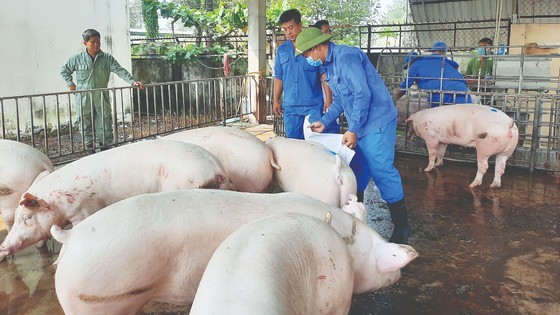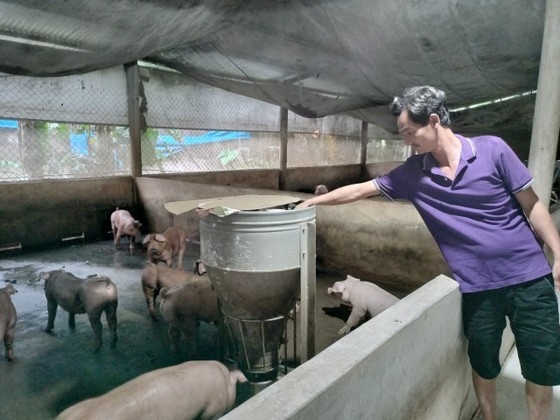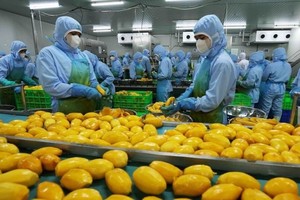 |
Sow raising model in Trang Bom District of Dong Nai Province |
Dong Nai Province is considered the capital of pig breeding in Vietnam with around 3,000 farms. At present, many households are temporarily halting their farm activities, leading to a drop of 8 percent of pig quantity compared to this time last year.
Farmer Nguyen Van Trung from Thong Nhat District shared that the live pig price now is VND51,000 – 54,000 per kilo (US$2.08 – 2.21), a drop of VND7,000 ($0.29) a kilo as opposed to 2 months ago. Meanwhile, the prices of fodder have increased continuously. Therefore, farmers can experience a financial loss of VND1 million ($41) per pig, so they are no longer interested in restocking the herd.
A similar story can be found in Tay Ninh Province. Nguyen Dinh H. from Tan Chau District shared that even though his family has prepared the barn to raise pigs, chickens, and ducks, the prices of breeds and fodder are too high whereas livestock prices are going down, making him reluctant to invest.
Deputy General Director of C.P. Livestock Co. Le Xuan Huy shared that the pig herd of the company also sees a quantity drop as some of their partner farms cannot satisfy environment-related criteria. Adding to that is the possible outbreak of African Swine Fever (ASF) on both pigs and humans, and hence farmers are not confident enough to re-herd their livestock. The good news is the company is still able to ensure sufficient pork for the upcoming Tet holiday.
General Director Nguyen Ngoc An of Vissan JSC. informed that his company’s plan this year is the same as last year’s one to provide about 1,000 – 1,500 pigs to the domestic market on Tet holiday. Vissan has signed contracts with farms for a stable pig supply. Also, there is no need to worry about pork shortage because of the predicted weak purchasing power next year. As to the low live pig price, farmers are afraid of ASF and tend to sell their pigs at the weight of 60-70kg to avoid financial damage; so when the disease is under control and farmers are more confident to restock their herds, this price will certainly go up.
The Dong Nai Province Division of Animal Health blamed the drop in the pig quantity on high fodder and low live pig prices. In addition, as many businesses are temporarily closing due to a lack of orders, there is a reduction in the pork demand for industrial meals. Besides the possible outbreak of ASF, many districts in the province are checking farms and determinedly relocating troublesome ones to new places, creating certain disturbance to pig herds.
Meanwhile, in Tay Ninh Province, some large-scale pig farms are still carrying out the re-herding process, and the province now has 300,000 pigs in 40 such business farms as well as 100 small-scale family farms. Obviously, fluctuations in fodder prices do not have much influence on enterprises, which are financially capable. They still have sufficient capital to raise livestock for the peak time.
 |
Farmer Vu Van Vinh in Trang Bom District of Dong Nai Province is reluctant to re-herd his pigs due to high fodder but low live pig prices |
The situation is brighter in the Mekong Delta, where farmers are more eager to re-herd their livestock for the market at the end of this year and the upcoming Tet holiday.
Compared to this time last year, Tien Giang Province is experiencing a rise of 3 percent in pig herds to reach over 290,000 pigs and is predicted to continue this upward trend to serve the market on Tet holiday next year.
Hau Giang Province is also seeing bustling pig raising activities. At present, the total number of cattle here is 145,000, accounting for 90 percent of the time before the ASF outbreak. The functional agencies in the province actively update knowledge for farmers and strictly monitor the disease status of livestock herds.
According to the Department of Livestock and Husbandry (under the Ministry of Agriculture and Rural Development), it takes 4-6 months to raise a pig to adulthood. In order to ensure sufficient pork for the next Tet holiday, the local authorities should carefully instruct farmers on re-herding.
Lately, the prices of live pigs have seen a considerable drop in all regions of Vietnam to only VND48,000 - 51,000 per kilo ($1.97 - 2.08).
Meanwhile, Head of the Department of Livestock and Husbandry Duong Tat Thang assured that there will not be any pork shortage at the end of this year and beginning of next year since the total quantity of pigs nationwide is 27 million. The national pork output until September 2023 was 3.63 million tonnes, a rise of nearly 7 percent compared to this time last year. Plus, Vietnam is able to import pork if the retail prices are too high as it is now enjoying import-export tax rates of nearly 0 percent.
Statistics from the General Department of Customs reveal that in the first 8 months this year, about 12,200 tonnes of pork worth $30.5 million were imported, an increase of 29 percent in quantity and 56 percent in value as opposed to this time last year. This is the fourth consecutive month that Vietnam has experienced pork import growth in 2023.
























